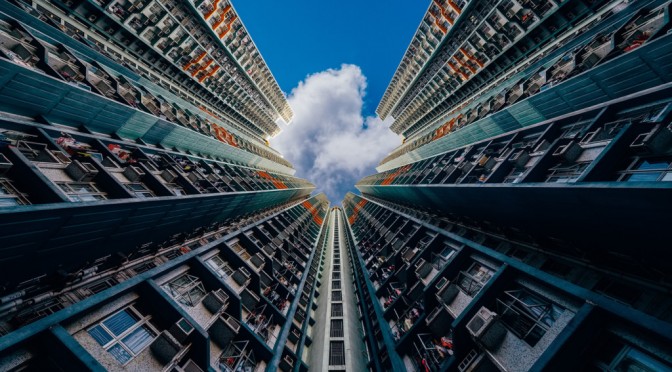
SOME 7.2 MILLION people live in Hong Kong, a region that covers 426 square miles. Cramming that many people into so small an area requires building up. And up. And up. Peter Stewart’s series Stacked provides a dizzying view of the high-rises most Hongkongers call home.
Hong Kong is renowned for its deep harbor and amazing skyline, which features more than 1,500 skyscrapers. The very tallest of them are office buildings, but even apartment buildings rise 250 feet or more, allowing those on the ground to see only slivers of sky through a canyon of concrete, steel, and glass. “Once you comprehend the reality of [Hong Kong], it really makes sense that the only way to to build is up,” Stewart says.
The British photographer started the project while visiting Hong Kong in 2013. Wandering the city he now calls home, he happened upon the Yick Cheong Building in Quarry Bay. The high-rise looks like thousands of cubes piled one atop the other like colorful wood blocks. Stewart couldn’t help but snap a pic. “In the last few years, this has become one of the top photo spots for local Instagrammers to frequent,” he says. “Almost every time I’m passing by, I’ll find a group of likeminded people taking photos here, equally wowed by this structure.”
The apartment tower reminded him of the legendary Kowloon Walled City. The squatter’s settlement contained 33,000 people within a sliver of land covering just 6.4 acres before it was demolished in 1992. Stewart decided to photograph equally awe-inspiring high-rises.
He’s since photographed more than 300 residential towers. Stewart achieves his signature POV by finding the point midway between the buildings and aiming his digital camera straight up. A 14mm lens lets him capture the symmetry and repetition of buildings on both sides, and distorts the view to create an almost surreal image. “I just find it fascinating how an ordinary structure which from the outside has no artistic appeal can be so interesting architecturally when viewed from the right perspective,” he says.
Stewart takes multiple exposures at various shutter speeds, blending them in Photoshop so the bright lights in the windows aren’t blown out against the darker exposure of the skyline. He also plays with color for a futuristic feel. Such “digital fakery,” as Stewart calls it, evokes a melancholic, almost dystopian mood. It’s hard to imagine people relaxing or playing in such a place, but Stewart says he’s often surrounded by people playing cards, doing Tai Chi, and having a fine time. “That’s the great lie hidden in the image,” Stewart says. “The reality is that many of these locations are thriving communities.”

Leave a Reply